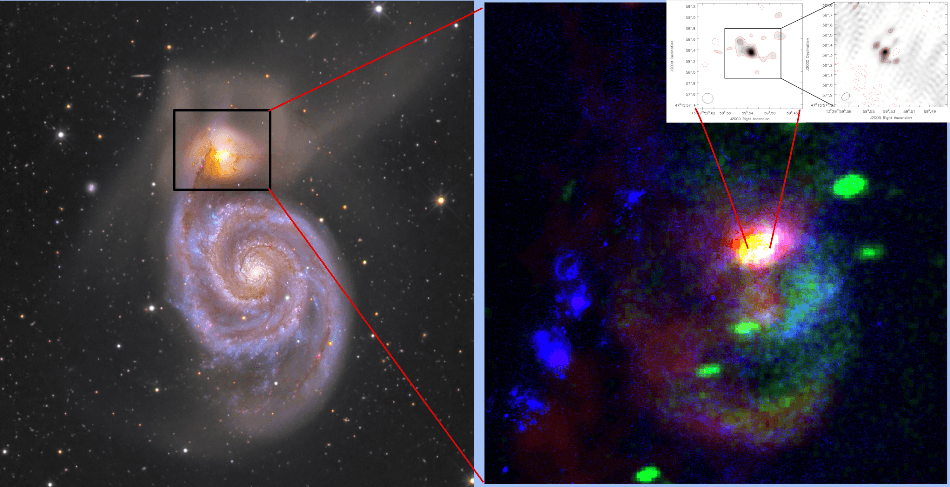Jul 5 2017
A multi-wavelength research on a pair of colliding galaxies has exposed the cause of a supermassive black hole's case of 'indigestion'. At the National Astronomy Meeting at the University of Hull, the research findings will be presented by Dr Hayden Rampadarath.
 Left: Image of the Whirlpool galaxy and NGC 5195. Credit: Jon Christensen. Right: False color image of NGC 5195 created by combining the VLA 20 cm radio image (red), the Chandra X-ray image (green), and the Hubble Space telescope H-alpha image (blue). The image shows the X-ray and H-alpha arcs, as well as the radio outflows from the supermassive black hole at the centre of NGC 5195. Credits: NRAO / AUI / NSF / NASA / CXC / NASA / ESA / STScI / U. Manchester / Rampadarath et al. Right inset: e-MERLIN maps of the nuclear region of NGC 5195 at 1.4 GHz (left) and 5 GHz (right). The images display a partially resolved source with possible parsec-scale outflows. (Credit: e-MERLIN / U. Manchester / Rampadarath et al.)
Left: Image of the Whirlpool galaxy and NGC 5195. Credit: Jon Christensen. Right: False color image of NGC 5195 created by combining the VLA 20 cm radio image (red), the Chandra X-ray image (green), and the Hubble Space telescope H-alpha image (blue). The image shows the X-ray and H-alpha arcs, as well as the radio outflows from the supermassive black hole at the centre of NGC 5195. Credits: NRAO / AUI / NSF / NASA / CXC / NASA / ESA / STScI / U. Manchester / Rampadarath et al. Right inset: e-MERLIN maps of the nuclear region of NGC 5195 at 1.4 GHz (left) and 5 GHz (right). The images display a partially resolved source with possible parsec-scale outflows. (Credit: e-MERLIN / U. Manchester / Rampadarath et al.)
Once every few hundred million years, the small galaxy NGC 5195 falls into the outer arms of its larger companion, NGC 5194, also referred to as the Whirlpool galaxy. Both galaxies are locked in a gravitational dance that will bring about – billions of years in the future – the formation of a single galaxy.
An accretion disc is formed when NGC 5195 plunges into the Whirlpool and matter streams onto the supermassive black hole at NGC 5195's center. The disc grows so much where the supermassive black hole can no longer accrete or 'digest' efficiently and matter is blasted out into the neighboring interstellar medium. Last year, NASA's Chandra X-Ray observatory spotted arcs of X-ray emission that appeared to happen due to this 'force-feeding'.
Now, new high-resolution images of the center of NGC 5195, captured with the e-MERLIN radio array, and archive images of the neighboring area from the Very Large Array (VLA), Chandra and the Hubble Space Telescope, reveal comprehensively how these blasts happen and spread. The research was led by Astronomers at the University of Manchester's Jodrell Bank Centre for Astrophysics.
The supermassive black hole at the center of NGC 5195 has a mass that is equivalent to 19 million Suns. When the accretion process fails, enormous forces and pressures create a shock wave that forces matter out into the interstellar medium. Electrons, accelerated close to the speed of light, act together with the magnetic field of the interstellar medium and release energy at radio wavelengths. The shock wave then inflates and heats up the interstellar medium, which emits in the X-ray and strips the electrons from adjacent neutral hydrogen atoms to produce ionized hydrogen gas. This inflated bubble forms the arcs detected by Hubble and Chandra.
Comparing the VLA images at radio wavelengths to Chandra's X-ray observations and the hydrogen-emission detected by Hubble, shows that features are not only connected, but that the radio outflows are in fact the progenitors of the structures seen by Chandra and Hubble. This is an event of galactic proportions that we can see right across the electromagnetic spectrum.
Dr Hayden Rampadarath
He adds, "The age of the arcs in NGC 5195 is 1-2 million years. To put that into context, the first traces of matter were being forced out of the black hole in this system at about the time that our ancestors were learning to make fire. That we are able to observe this event now through such a range of astronomical facilities is quite remarkable."